The basic purpose of a machine bearing is to
provide a near frictionless environment to support and guide a rotating shaft. Two general
bearing styles are utilized at this time: the journal bearing and the rolling element
bearing. For lower horsepower and lighter loaded machines, the rolling element bearing is
a popular choice.
Until the 1940's, the journal bearing was the prevalent style used on
machines. As metallurgy and machining techniques progressed, the rolling element bearing
gained greater usage. Today many of the smaller process support machines have rolling
element bearings.
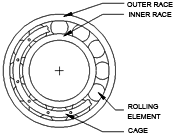 Bearing Designs Bearing Designs
Rolling
Element Bearings have four components: an inner race, an outer race, a rolling element,
and a cage to support, space, and guide the rolling elements. The rolling elements found
in today's rolling element bearings include: balls, rollers, and tapered rollers. All
rolling element bearings have one thing in common: all parts must be in physical metal to
metal contact at all times. Installation instructions specify the amount of bearing
pre-load to maintain the component contact.
Rolling element bearings have some unique concerns not found in journal bearings. A
rolling element bearing will always force a vibration node at its location. Because of the
metal to metal contact, this bearing will provide very little vibration damping. Although
these bearings are a very precisely machined part they have a limited lifetime. Each
component of the bearing will generate specific frequencies as defects initiate and become
more prevalent.
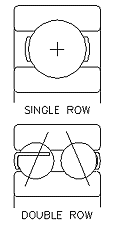 Spherical Ball Spherical Ball
Spherical
ball bearings, as the name implies, utilize spherically shaped balls as the rolling or
load carrying element. The number of balls used in a bearing varies depending on the
application. This rolling element bearing type is designed to carry both radial and axial
loads. By modifying the design, this bearing can also accommodate large axial loads.
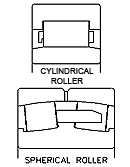 Cylindrical/Spherical Roller Cylindrical/Spherical Roller
This type of bearing utilizes cylindrically
shaped rollers as the load carrying element. This bearing type is designed to carry large
radial loads. This bearing, in its basic configuration, is not well suited to counter
axial loads. The rollers may actually be slightly barrel shaped in certain designs. Barrel
shaped rollers and their associated outer race allow for some self alignment of the
bearing. Needle bearings are a special adaptation of the cylindrical roller bearing.
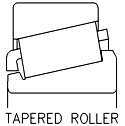 Tapered Roller/Land Tapered Roller/Land
This bearing design is a special adaptation of the cylindrical roller bearing.
This bearing is designed to counter axial thrust loads along with carrying radial loads.
Due to the geometrical summation of the radial and axial loads, this bearing has a lower
radial load limit than a similarly sized cylindrical or spherical bearing.
Certain applications may employ tapered rollers along with tapered races, hence the
name. Special bearings may have inner and outer races with differing angles.
Vibration Monitoring Applications
Rolling element bearings, by their design and installation, provide a very good signal
transmission path from the vibration source to the outer bearing housing. Also, these
bearings require monitoring of the unique bearing frequencies generated by the various
parts of the bearing, in addition to the rotor fault frequencies.
Bearing Frequency Calculation
Although modern rolling element bearings are very precisely machined, they do have
micro-defects which are potential sites for future damage. Due to the precise tolerances,
improper installation practices can reduce bearing life. Extensive information has been
compiled about bearing defect frequencies.
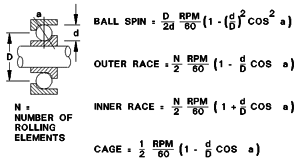
The figure lists the bearing defect frequency formulas for a defect on the balls or
rollers, outer race, inner race, and cage. The assumption for these formulas is that the
outer race is stationary while the inner race rotates.
If the bearing dimensions are known, the individual bearing defect frequencies can be
calculated precisely, or a general rule of thumb can be applied. Using the generalized
form the inner race frequencies would be N x RPM x 60% and the outer race frequencies
would be N x RPM X 40%. If the bearing manufacturer model numbers are known several
computer programs are available to calculate the necessary frequencies.
Failure Monitoring
This style of bearing is typically monitored using a case mounted transducer: an
accelerometer or velocity pickup. A displacement sensor observing the shaft relative
vibration would show little, if any, vibration due to the vibration node created by the
bearing.
Using signal integration techniques, found in many industrial data collectors,
specific frequency ranges relating to certain defects can be emphasized. Acceleration
signals, obtained from case mounted sensors, emphasize high frequency sources, while
displacement signals emphasize lower frequency sources, with velocity signals falling
between the extremes. Recent innovations for determining bearing condition are
Acceleration Enveloping, Spectral Emitted Energy (SEE), and Spike Energy. These measure
high frequency resonances generated by bearing defects. As a trended variable, in
conjunction with other parameters such as displacement, velocity or acceleration, they can
give the earliest indication of bearing defects.
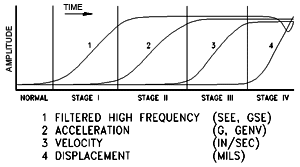
The figure depicts the overall amplitude levels obtained from a bearing as it progresses
through continuing phases of failure. This chart depicts overall vibration levels only. As
time progresses the earliest indication of failure are obtained from filtered high
frequency signals because these signals are generated by the resonance of the bearing and
by bearing component defects.
During the early stages of failure the other three parameters may not generate enough
signal to be detected because these parameters emphasize progressively lower frequency
ranges. As failure continues and the damaged bearing generates the individual bearing
defect frequencies, the other parameters register signals.
Viewing the four monitoring parameters as spectra, additional information
can be obtained about the failure modes.
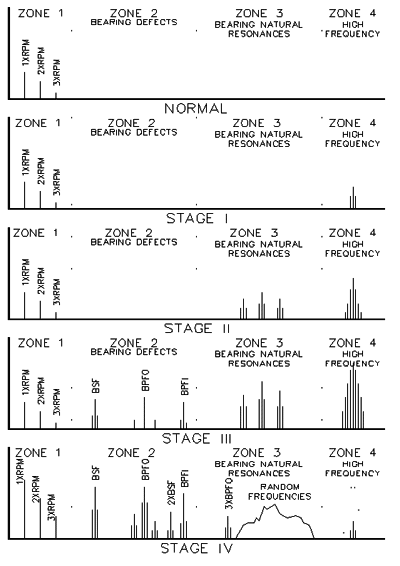
This figure shows the spectrum frequency content
during four stages of bearing failure. A normal bearing or newly installed bearing will
show no frequencies except those associated with shaft phenomenon such as balance or
misalignment.
Stage I
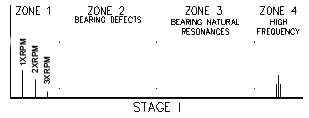
Stage I has some very high frequency content in the Spike Energy region. This zone is in
the ultrasonic region which requires a sensor specifically designed to detect in this
region. Special circuitry filters pass only those signals. Physical inspection of the
bearing at this stage may not show any identifiable defects.
Stage II
Stage II begins to generate signals associated with natural resonance frequencies of the
bearing parts as bearing defects begin to "ring" the bearing components. A
notable increase in Zones 3 and 4 region signals is associated with this stage. Beginning
signs of defects will be found upon inspection.
Stage III
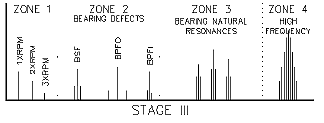
Stage III condition has the fundamental bearing defect frequencies present. These
frequencies are those discussed previously in this paper. Harmonics of these frequencies
may be present depending upon the quantity of defects and their dispersal around the
bearing races. The harmonic frequencies will be modulated, or side banded, by the shaft
speed. Zone 4 signals continue to grow throughout this stage.
Stage IV
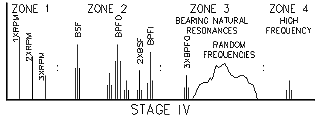
Stage IV is the last condition before catastrophic failure of the bearing. This stage is
associated with numerous modulated fundamental frequencies and harmonics indicating that
the defects are distributed around the bearing races. Due to the increased degradation of
the bearing the internal clearances are greater and allow the shaft to vibrate more freely
with associated increases in the shaft frequencies associated with balance or
mis-alignment. During later phases of stage IV, the bearing fundamental frequencies will
decline and be replaced with random noise floor or "hay stack" at higher
frequencies. Zone 4 signal levels will actually decrease with a significant increase just
prior to failure.
|

